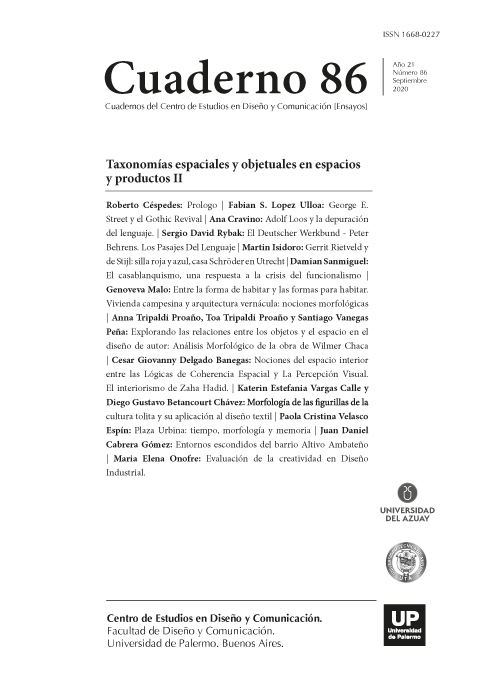George E. Street y el Gothic Revival
Abstract
George E. Street (1824-1881) is considered one of the most outstanding designers of Gothic Revival during the splendor of the United Kingdom in Victorian times, with GG Scott, W. Butterfield, or W. Burges. He represented through his prolific work, a period charged with symbolism around a canonical style with a marked religious accent that Pugin considered as an ideal of nation. Therefore, he was subject to opinions that defended, on the one hand, the purist sense in the management of style, related only to the influence of English Gothic, and on the other hand, the inclusion of some continental influence related to the rest of Europe. A style that not only had to do with the strict sense of its application to a new work, but also in how it was applied in the innumerable reforms, extensions and restorations of which an infinity of Gothic buildings were object. To this extent, the present investigation delves into the stylistic resources handled by George E. Street and how his work was consecrated not only in the field of architectural design but also in the design of furniture and accessories.
References
Aldrich, M. (1999). Gothic Revival. London: PhaidonPress Ltd.
Bingham, N. (2011). Masterworks: Architecture at the Royal Academy of Arts, London: RA.
Brownlee, D. (1984). The Law Courts: The Architecture of George Edmund Street. New York, Cambridge: Architectural History Foundation, MIT Press.
Germann, G. (1972).“G. E. Street and Switzerland,” en ZeitschriftfürSchweizerischeArchä ologieundKunstgeschichte, vol. 29, Nº 2 y 3, Zurich: SchweizerischesNationalmuseum, p.118–130.
___. (2009). Aux origines du patrimoinebâti, Gollion–Suisse: Infolio.
Girón, F. (2016). Prólogo, en George E. Street, La arquitectura gótica en España, F. S. López Ulloa (ed.), Madrid: Instituto Juan de Herrera, pp. ix-xii.
Gubler, J. e I. Davies. (1976).“Street and Viollet–le–Duc,” en The Architectural Review, Sep., vol. CLX, Nº 955, London: The Architectural Press Ltd., p. 189.
Hitchcock, H. R. (1960). “G. E. Street in the 1850's,” en The Journal of the Society of Architectural Historians, vol. 19, no. 4, Chicago: Society of Architectural Historians, pp. 145-71.
Jackson, N. (1980). “The Un-Englishness of G. E. Street'sChurch of St James-the-Less,” en Architectural History, vol. 23, London: SAHGB PublicationsLimited, pp. 86-94,191-5.
Jackson, N. (2011). “George Edmund Street (1824-81): AnArchitect on Holiday,” en Episodes in the Gothic Revival SixChurch Architects, Christopher Webster (ed.), Reading: SpireBooksLtd, pp. 163-98.
López Ulloa, F. S. (2009). “George Edmund Street (1824–1881) y su contribución al estudio de la Arquitectura Gótica en España,” en Actas del Sexto Congreso Nacional de Historia de la Construcción, Valencia, 21-24 de octubre de 2009, Santiago Huerta et al (ed.), Madrid: Instituto Juan de Herrera, pp. 789-801.
___. (2010). “The Theory and Practice of Restoration in England in the Second Half of the 19th Century: The Work of George E. Street,” en Advanced Materials Research, vols. 133-4, Switzerland: Trans Tech Publications, pp. 1045-50.
___. (2015). “George E. Street, su vida, su legado y la arquitectura gótica española,” en George E. Street, La arquitectura gótica en España, F. S. López Ulloa (ed.), Madrid: Instituto Juan de Herrera, pp. xvii-lv.
___. (2016). Las teorías del gótico y su representación gráfica en España en el último tercio del siglo XIX. Un estudio sobre SomeAccount of Gothic Architecture in Spain, de George Edmund Street, Tesis Doctoral, Madrid: Universidad Politécnica de Madrid.
López Ulloa, F. S. y F. J. Girón. (2014). “Los dibujos de arquitectura gótica española de George E. Street,” en El dibujo de viaje de los arquitectos. Actas del 15 Congreso Internacional de Expresión Gráfica Arquitectónica. Las Palmas de Gran Canaria, del 22 al 23 de mayo de 2014, A. Melián (ed.), Las Palmas de Gran Canaria: Universidad de las Palmas de Gran Canaria.
Pokropek, J. (2018). “Lógicas de coherencia para la interpretación y producción del diseño interior y sus criterios de selección de formas objetuales,” en Cuadernos del Centro de Estudios en Diseño y Comunicación, Cuaderno 81, Buenos Aires: Universidad de Palermo.
Pugin, A. W. (1836). Constrastsor, a parallelbetween the noble edifices of the fourteenth and fifteenthcenturies, and similar buildings of the presentday; shewing the presentdecay of taste, London.
Saint, A. (1995). “Pugin's Architecture in Context,” enA. W. N. Pugin: Master of Gothic Revival. New Haven – London: Yale University Press, pp. 79-102.
Stamp, G. (2003). “High Victorian Gothic and the Architecture of Normandy,” en Architectural History, vol. 62, no. 2, Jun., London: SAHGB PublicationsLimited, pp. 194-211.
Street, A. (1888). Memoir of George Edmund Street, R.A., 1824-1881. London: John Murray.
Street, G. E.(1853). “On the revival of the ancientstyle of domesticarchitecture,” en The Ecclesiologist, vol. XIV, no. XCV, London: The Ecclesiological Late Cambridge Camden Society, pp. 70-80.
___. (1855). Brick and Marble in the MiddleAges: Notes of a Tour in the North of Italy, London: John Murray. ___. (1865). SomeAccount of Gothic Architecture in Spain, London: John Murray.
___. et al. (1882). The Cathedral of the Holy Trinity, commonly called Christ Church Cathedral, Dublin: anaccount of the restoration of the fabric, London: Sutton Sharpe and co.
Summerson, J. (1970). “The law Courts competition of 1866-67,” en RIBA Journal, january 1970, London: RIBA. Victorian Church Art. (1971).Victorian Church Art, ExhibitionNovember 1971 – January 1972, Victoria & Albert Museum, London: Victoria & Albert Museum
Los autores/as que publiquen en esta revista ceden los derechos de autor y de publicación a "Cuadernos del Centro de Estudios de Diseño y Comunicación", Aceptando el registro de su trabajo bajo una licencia de atribución de Creative Commons, que permite a terceros utilizar lo publicado siempre que de el crédito pertinente a los autores y a esta revista.


